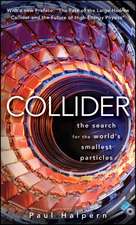Collisional Effects on Molecular Spectra: Laboratory Experiments and Models, Consequences for Applications
Autor Jean-Michel Hartmann, Christian Boulet, Daniel Roberten Limba Engleză Hardback – 10 aug 2008
In practice, the radiating molecule is usually not isolated but diluted in a mixture at significant total pressure. The collisions among the molecules composing the gas can have a large influence on the spectral shape, affecting all wavelength regions through various mechanisms. These must be taken into account for the correct analysis and prediction of the resulting spectra.
This book reviews our current experimental and theoretical knowledge and the practical consequences of collisional effects on molecular spectral shapes in neutral gases. General expressions are first given. They are formal of difficult use for practical calculations often but enable discussion of the approximations leading to simplified situations. The first case examined is that of isolated transitions, with the usual pressure broadening and shifting but also refined effects due to speed dependence and collision-induced velocity changes. Collisional line-mixing, which invalidates the notion of isolated transitions and has spectral consequences when lines are closely spaced, is then discussed within the impact approximation. Regions where the contributions of many distant lines overlap, such as troughs between transitions and band wings, are considered next. For a description of these far wings the finite duration of collisions and concomitant breakdown of the impact approximation must be taken into account. Finally, for long paths or elevated pressures, the dipole or polarizability induced by intermolecular interactions can make significant contributions. Specific models for the description of these collision induced absorption and light scattering processes are presented.
The above mentioned topics are reviewed and discussed from a threefold point of view: the various models, the available data, and the consequences for applications including heat transfer, remote sensing and optical sounding. The extensive bibliography and discussion of some remaining problems complete the text.
- State-of-the-art on the subject
- A bibliography of nearly 1,000 references
- Tools for practical calculations
- Consequences for other scientific fields
- Numerous illustrative examples
- Fulfilling a need since there is no equivalent monograph on the subject
| Toate formatele și edițiile | Preț | Express |
|---|---|---|
| Paperback (1) | 1133.13 lei 5-7 săpt. | |
| ELSEVIER SCIENCE – 15 ian 2021 | 1133.13 lei 5-7 săpt. | |
| Hardback (1) | 887.53 lei 5-7 săpt. | |
| ELSEVIER SCIENCE – 10 aug 2008 | 887.53 lei 5-7 săpt. |
Preț: 887.53 lei
Preț vechi: 1243.77 lei
-29% Nou
Puncte Express: 1331
Preț estimativ în valută:
169.89€ • 178.34$ • 140.34£
169.89€ • 178.34$ • 140.34£
Carte tipărită la comandă
Livrare economică 23 ianuarie-06 februarie 25
Preluare comenzi: 021 569.72.76
Specificații
ISBN-13: 9780444520173
ISBN-10: 0444520171
Pagini: 432
Dimensiuni: 165 x 240 x 25 mm
Greutate: 0.93 kg
Editura: ELSEVIER SCIENCE
ISBN-10: 0444520171
Pagini: 432
Dimensiuni: 165 x 240 x 25 mm
Greutate: 0.93 kg
Editura: ELSEVIER SCIENCE
Public țintă
Research workers in the fields of spectroscopy, remote sensing, optical sounding and radiative heat transfer in gas mediaUniversity libraries (PhD students)
Cuprins
I. IntroductionII. General EquationsIII. Isolated LinesIV. Collisional Line-Mixing (within clusters of lines)V. The Far Wings (beyond the impact approximations)VI. Collision Induced Absorption and Light ScatteringVII. Consequences for ApplicationsVIII. Towards Future Researches
Recenzii
"Gas spectroscopy has been used to identify materials based on district line patterns emitted by excited molecules in the material." --IEEE: Electrical Insulation Magazine














